 Naples is one of the Italian cities we’ve more or less avoided over the years, possibly because of its reputation, which isn’t so good. About 9 years ago we were driving from Pompeii to Rome and got shortchanged at a Naples tollbooth. That’s about as close as we’ve got till now.
Naples is one of the Italian cities we’ve more or less avoided over the years, possibly because of its reputation, which isn’t so good. About 9 years ago we were driving from Pompeii to Rome and got shortchanged at a Naples tollbooth. That’s about as close as we’ve got till now.
Our Tuscan friends have told us to avoid Naples. “There is too much crime,” they tell us. “If you drive to Naples with a Florence license tag, they’ll take everything, even the car.”
The women sitting next to me on the train ride from Rome was born in Naples, although she now lives in Milan. She said the Napolitani don’t really care about the crumbling condition of the city. They accept it and could care less what tourists think. For some of them, the only good thing about tourists is when they get lost and end up in the Spanish Quarter at night. It’s easy pickins..
Someone told us when they were recently in Naples, a tourist meandered into the Spanish Quarter and as he held his camera to his eye, hoping to get a good photo, one of the locals grabbed the camera and then demanded everything else in his pockets. The tourists cried out but when the police arrived, they just helped the thieves.
They have a very tight network up there. Afterall, Naples is home to the Camorra, a mafia-like criminal organization. It’s roots go back to the 17th century, when the Spanish Bourbon kings controlled the city. The Camorra, named after the short jackets the men wore back then, used to be made up of vigilant citizens protecting Neapolitan women from the attacks of Spanish soldiers. Eventually their protection got a lot more lucrative. These days over 60% of the Napolitano business pay protection to the Camorra gangs.
The neighborhoods of the Spanish Quarter, dark, narrow streets enclosed on either side by 6 story, 18th century buildings are filled with Camorra gangs. Our hotel receptionist circled the area on the city map he handed to us and wrote NO in big bold letters. “It is OK to walk in the Spanish Quarter during the days, but not at night”. And so the first place we went to was the Spanish Quarter (it was daytime of course). It was kind of exciting; there’s a certain sense of danger, intrigue and forbidden pleasure. We never saw anyone who looked like they belonged to a gang, only old people or young mothers with small children. Either the gangsters were still asleep or they left town for the August holiday. Gretchen says the Spanish Quarter feels a lot like Little Italy in New York, probably because most of New York’s Italian immigrants came from Naples and Sicily. It was really pleasant, just a slice of life from the old neighborhood. But then, we were there in the daytime.
One day we stopped a policeman on the street and asked directions. He told us we should just find our way out of Naples. We told him it was our first time here and we didn’t think it was so bad. His response was “prima volta, l’ultima volta”, first time, last time.
We do listen to the myths and rumors, but we always prefer to form our own opinions based on our own experiences. However, a couple of minutes after we got into the cab at the Naples train station the driver turned off the meter. When we confronted him he explained he was going to give us his personal tour of Naples, but we then we explained we just wanted to just go to the hotel, and with the meter turned on. He told us since he already turned the meter off, he couldn’t turn it on again but we shouldn’t worry. He was an honest man, he said. The ride cost . The hotel receptionist told us it was a good price.
We’re staying at the Grand Hotel Vesuvio on the Via Partenope (named after the ancient Partenopeans who lived here the same time as the Romans). In 1891, the great tenor, Enrico Caruso made his debut at the old Bagni Risorgimento that once stood across the street from the hotel. He was 18 years old. Caruso never really sang in Naples once he became famous. As the story goes, he was booed once when he was younger and never forgot it. He did always came home to Naples for the food. He spent the last 7 days of his life in the suite of the Grand Hotel Vesuvio now called the Caruso Suite, of course. He died at age 48.
The suite has many of the same furnishings from Caruso’s last week, the same piano, the same phonograph with the loudspeaker trumpet and the same easy chair the Maestro used to use to gaze out at the bay.
 This was a pretty famous hotel in it’s day and once welcomed, to name a few, Humphrey Bogart, George Sanders, Sophia Loren, Vittorio Gassman, Marcello Mastriani, Harry Truman, Claudia Cardinale, Elizabeth Taylor and Benito Mussolini.
This was a pretty famous hotel in it’s day and once welcomed, to name a few, Humphrey Bogart, George Sanders, Sophia Loren, Vittorio Gassman, Marcello Mastriani, Harry Truman, Claudia Cardinale, Elizabeth Taylor and Benito Mussolini.
The Hotel has enjoyed a few makeovers in the years but the view is still the same. Our room looks out over the beautiful bay of Naples. We also have a great view of Mt Vesuvius and the amazing Castel dell’Ovo, the egg castle.
The story we heard was that the Castle’s name comes from a medieval legend that says that the Roman poet Virgil, who somehow developed a reputation as a great sorcerer in medieval times, had a magical egg put in the foundation of the fortress to help protect the Castle. Of course, no one knows where this magical egg might be, but the Castle does have some of the best views of the Bay of Naples. These days there is a beautiful boat harbor next to it worth some great local restaurants; seafood, pizza and pasta. Our favorite restaurant pizza place called Ciro’s is right outside the castle gate. We’ve been going there a lot, especially for the pizza although there are only so many times can you listen to “O sole mio”, “Funiculì Funiculà”, “That’s Amore”, “Theme from the Godfather”, “Santa Lucia” and “Amapola”?It’s enough to really make you hate accordion music (if you don’t hate it already).
Naples is the home of Pizza. In the late 18th century, the Napolitani added tomato sauce to flattened leavened bread and gave birth to the pizza. It was originally sold from open air pizza stands around the city but around 1830, pizza restaurants started opening up around the city. The most popular (especially for purists) are Marinara (tomato, oregano, garlic and basil) and Margherita, created in 1889 in honor of the visit of King Umberto I and Queen Margherita of Savoy. The Queen’s favorite was a pizza showing off the colors of the Italian flag – green (basil leaves), white (mozzarella), and red (tomatoes). It’s still made the same way.
Pizza purists get even weirder and in Naples, they follow really strict guidelines; the pizza must be baked in a wood-fired, domed oven at 485F for no more than 90 seconds. The dough must be kneaded by hand, no rolling pins of dough hooks allowed. The pizza cannot exceed 35cm in diameter and cannot be thicker than 33 mm in the center. And for the real pizza fundamentalists, only San Marzano tomatoes grown on the slopes of Mt Vesuvius can be used and the olive oil can only be drizzled clockwise.
The other favorite food we probably ate too much of was Rum Baba, a yeast cake saturated with rum. The French brought it to Naples, but don’t tell that to the Napolitani. There are lots of recipes for this treat, but the purists made the cake batter by hand and roll it into little cylinders.
The main reason we came to Naples was to make a visit to the Archaeology museum, where many of the treasures of Pompeii and Herculaneum ended up. I thought I checked the website to confirm the hours of operation. We showed up on Tuesday and guess what. That’s right, they were closed. We’ll be back again. Check for future posts.
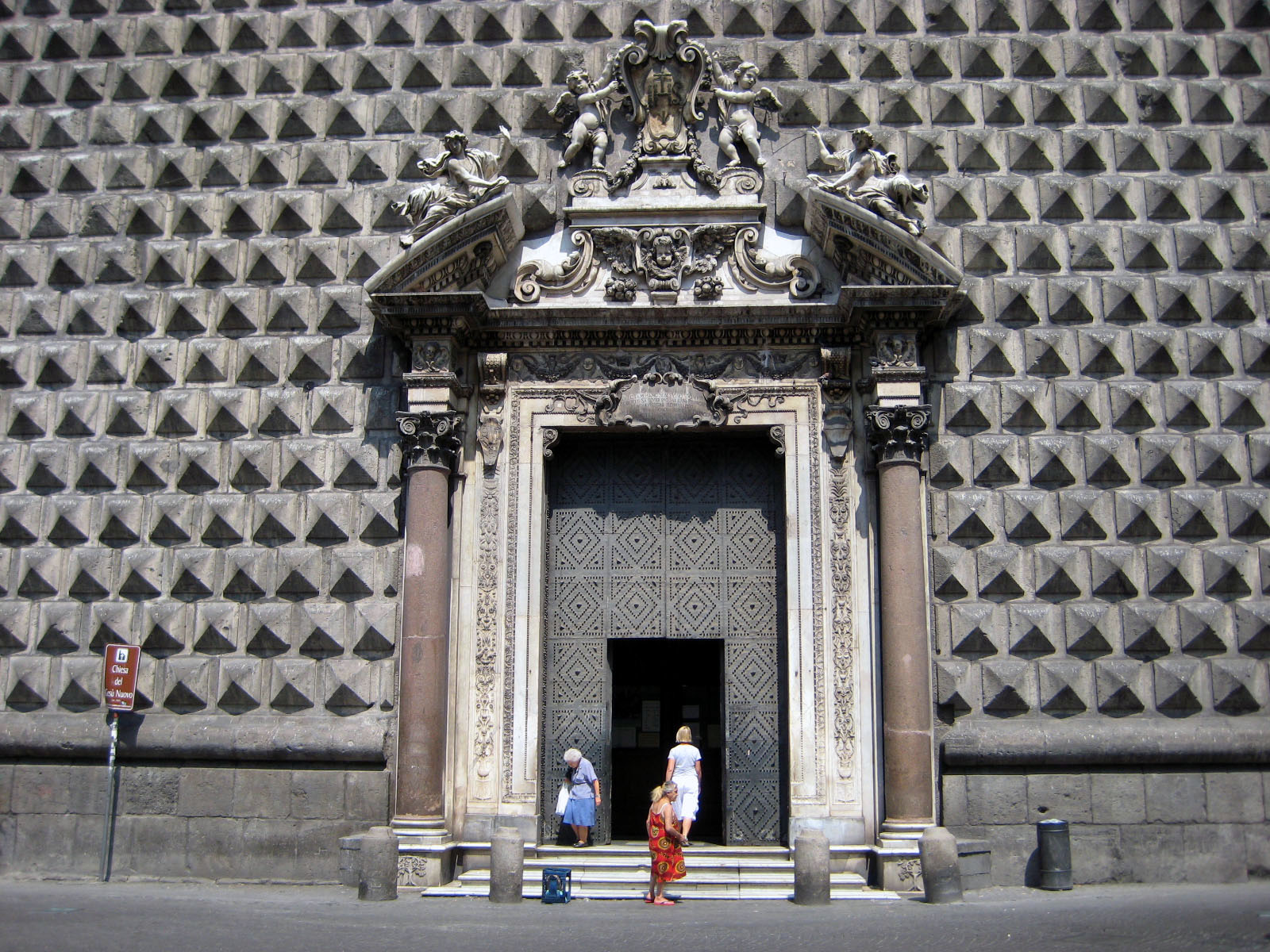 We spent the day wandering around the city, walking through the beautiful Piazza del Plebiscito near the Royal Palace. Right next to the Palace is the Teatro San Carlo, the oldest, active Opera House in Europe; inaugurated in 1737. Gioacchino Rossini was a house composer, so was Gaetano Donizetti. We tried to get in but we were told “tutto è chiuso” everything was closed. We snuck our way into the Teatro Massimo in Palermo when it was closed but the Napolitani would have nothing to do with us.
We spent the day wandering around the city, walking through the beautiful Piazza del Plebiscito near the Royal Palace. Right next to the Palace is the Teatro San Carlo, the oldest, active Opera House in Europe; inaugurated in 1737. Gioacchino Rossini was a house composer, so was Gaetano Donizetti. We tried to get in but we were told “tutto è chiuso” everything was closed. We snuck our way into the Teatro Massimo in Palermo when it was closed but the Napolitani would have nothing to do with us.
We walked up and down the Via Toldeo and in and out of the Spanish Quarter. We passed by public telephones pulled out of their booth harnesses as if someone thought people still used coins to make phone calls. We saw an homage to Sonny Bono as a clothing store that read “Sonny Bono, born trendy”. We saw the Convent of Santa Chiara and the very interesting extruded diamond exterior of the Gesu Duomo.
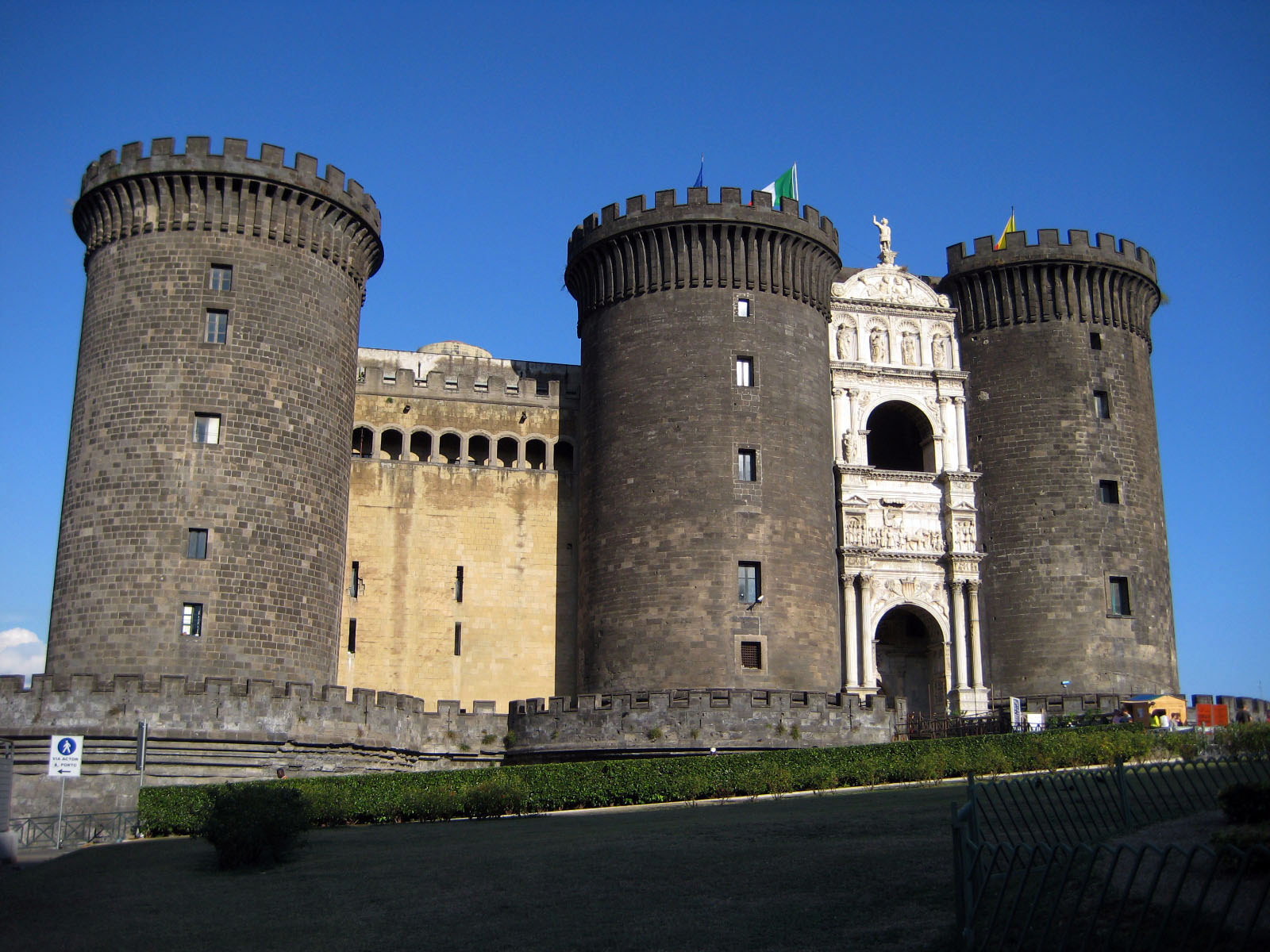 And then we ended up at the 13th century Castel Nuovo “New Castle”, often called Maschio Angioino.
And then we ended up at the 13th century Castel Nuovo “New Castle”, often called Maschio Angioino.
It’s the architectural symbol of Naples, although the Castel dell Ovo is much prettier.
Castel Nuovo was the home to the Bourbon Kings going back to Charles of Anjou in the 13th century. It was rebuilt up till 1823. The Kingdom of Naples fell to the Italian Unification in 1860.
These days Castel Nuovo is mostly used for concerts, business meetings and art installations. The art wasn’t so interesting but the views over the Bay of Naples are fabulous.There is one piece worth mentioning, a bronze door made in 1475 commemorating the victory of Ferrante of Aragon over John of Anjou and the “rebellious barons” (sounds like a 60’s rock band).
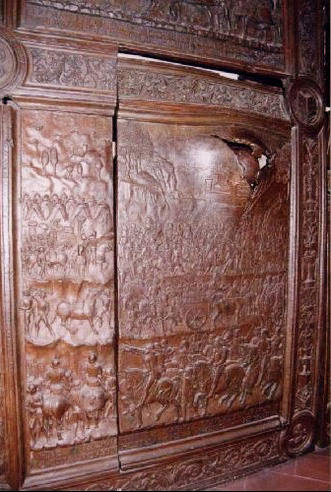 When the French defeated the Spanish a few years later, the French King, Charles VIII had the door loaded onto a ship bound for France, part of the spoils of the battle. Somewhere along the coast, the ship was attacked by the Genovese and during the battle, a small cannonball let fly and lodged itself into the door’s lower left quadrant. The Genovese returned the door (with the cannonball still embedded into it) to Naples in 1495.
When the French defeated the Spanish a few years later, the French King, Charles VIII had the door loaded onto a ship bound for France, part of the spoils of the battle. Somewhere along the coast, the ship was attacked by the Genovese and during the battle, a small cannonball let fly and lodged itself into the door’s lower left quadrant. The Genovese returned the door (with the cannonball still embedded into it) to Naples in 1495.
Overall, the city is a lot of fun. The trendy shopping districts are beautiful and very trendy. The boat harbors are postcard picturesque. The food is really good, especially the pizza. The weather is hot but there is always a good breeze, and the location of the city is one of the best in Italy, close to the ruins of Pompeii and Herculaneum by train, not far from the windng roads to the beautiful seaside villages of the Amalfi Coast by car and about 40 minutes or less by boat to the islands of Ischia, Procida and Capri.
We were actually surprised at how clean the city was. Sure, there are some beaten up old neighborhoods, but the graffiti was much less than in Rome and for the most part (with the exception of Saturday and Sunday) the garbage was picked up off the streets.
We read about the piles of rotting garbage in May, sweltering in the 34°C (94°F) heat of Naples streets. Most of the area’s landfill sites were full, and garbage collectors just stopped making their rounds. The frustrated Napolitano were torching garbage all over the city, lighting the hills with pockets of toxic flames. Schools were forced closed from invasions of mice. In 1973, Naples was the last major European city to suffer a cholera epidemic. But by the time we got there the garbage “seemed” under control.
Capri
The main ferryboat harbor (Porto Beverello) was a 10 minute walk from our hotel and there are at least 5 companies sending everything from a small ferry to a larger car ferry to Capri, Ischia and Procida. If you miss one, don’t worry; there is another one departing within 30 minutes. I used to think the larger the boat the less the chance I’d get seasick. Wrong.. Even Gretchen, a boating enthusiast, was turning a whiter shade of pale.
Since there are no cars allowed in Capri in the summer, we had our choice of any boat we wanted. The island gets so populated during the summer months they can hardly keep up with their own traffic, mostly cabs with the back half of the roof chopped off and replaced with cute awnings. It’s very colloquial.
If we had two words to describe Capri they would be “too crowded”.
Granted, we took the ferry over on Sunday August 15th, THE day of the Feragosto Holiday. All Italians take off in August, some the entire month, some just a week or two. But everyone takes off on the 15th.
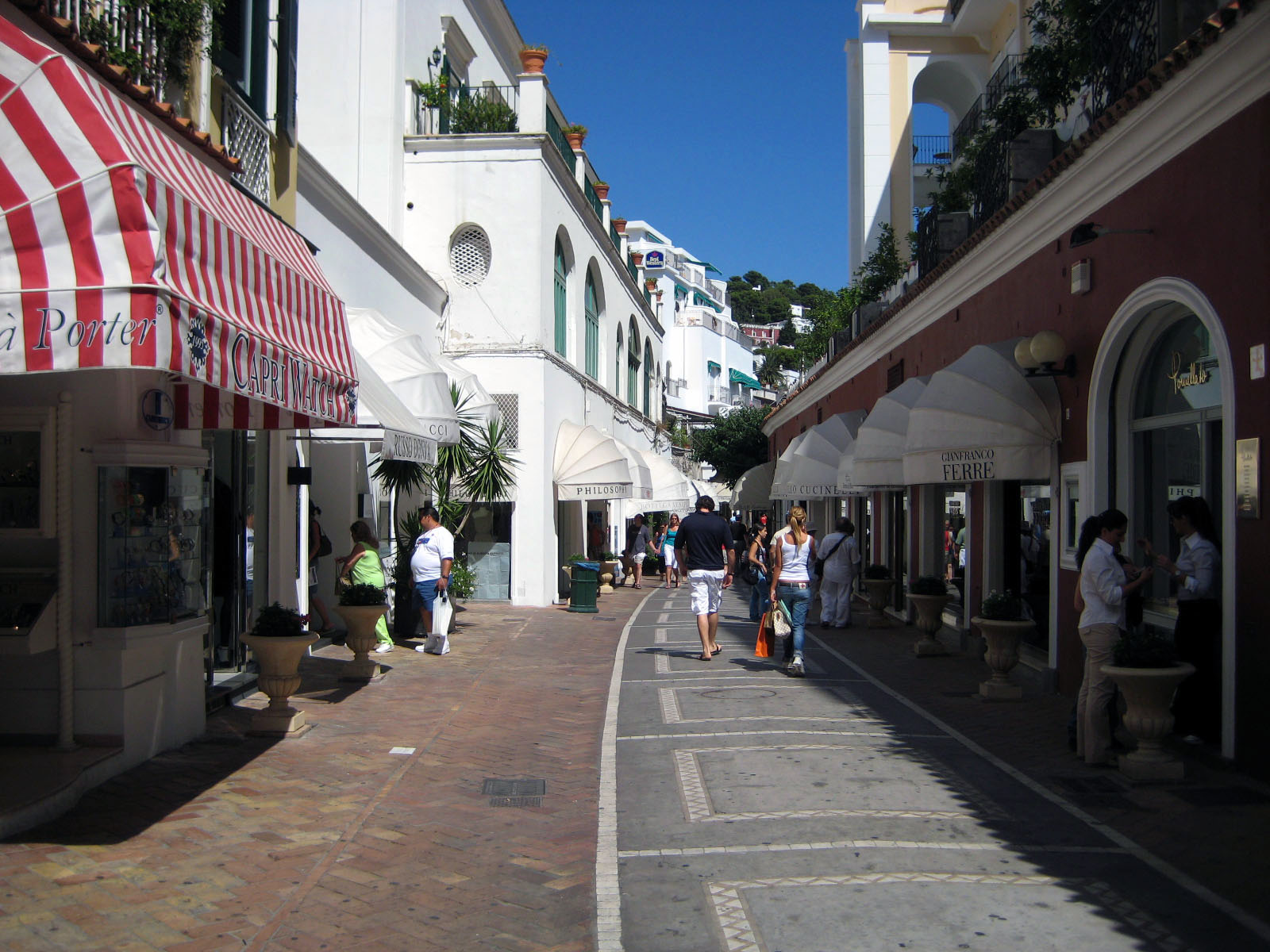 At one point I tried to take a photo to show how many people there were in the “Piazetta”, the main square of the town of Capri but there were too many people in the way. I haven’t seen crowds like this since Rock festivals back in the 1960’s. There were Napolitani, Brits, Germans, a few Americans and marching armies of cruise ship tourists wearing special color coded armbands, their leader holding up an umbrella, or flag as if they were marching into battle. There was no ducking down a small side street. Everyone else was already there. I have no idea how I was able to take this photo of one of the main shopping streets without the hordes of people. Maybe the shops were all closed.
At one point I tried to take a photo to show how many people there were in the “Piazetta”, the main square of the town of Capri but there were too many people in the way. I haven’t seen crowds like this since Rock festivals back in the 1960’s. There were Napolitani, Brits, Germans, a few Americans and marching armies of cruise ship tourists wearing special color coded armbands, their leader holding up an umbrella, or flag as if they were marching into battle. There was no ducking down a small side street. Everyone else was already there. I have no idea how I was able to take this photo of one of the main shopping streets without the hordes of people. Maybe the shops were all closed.
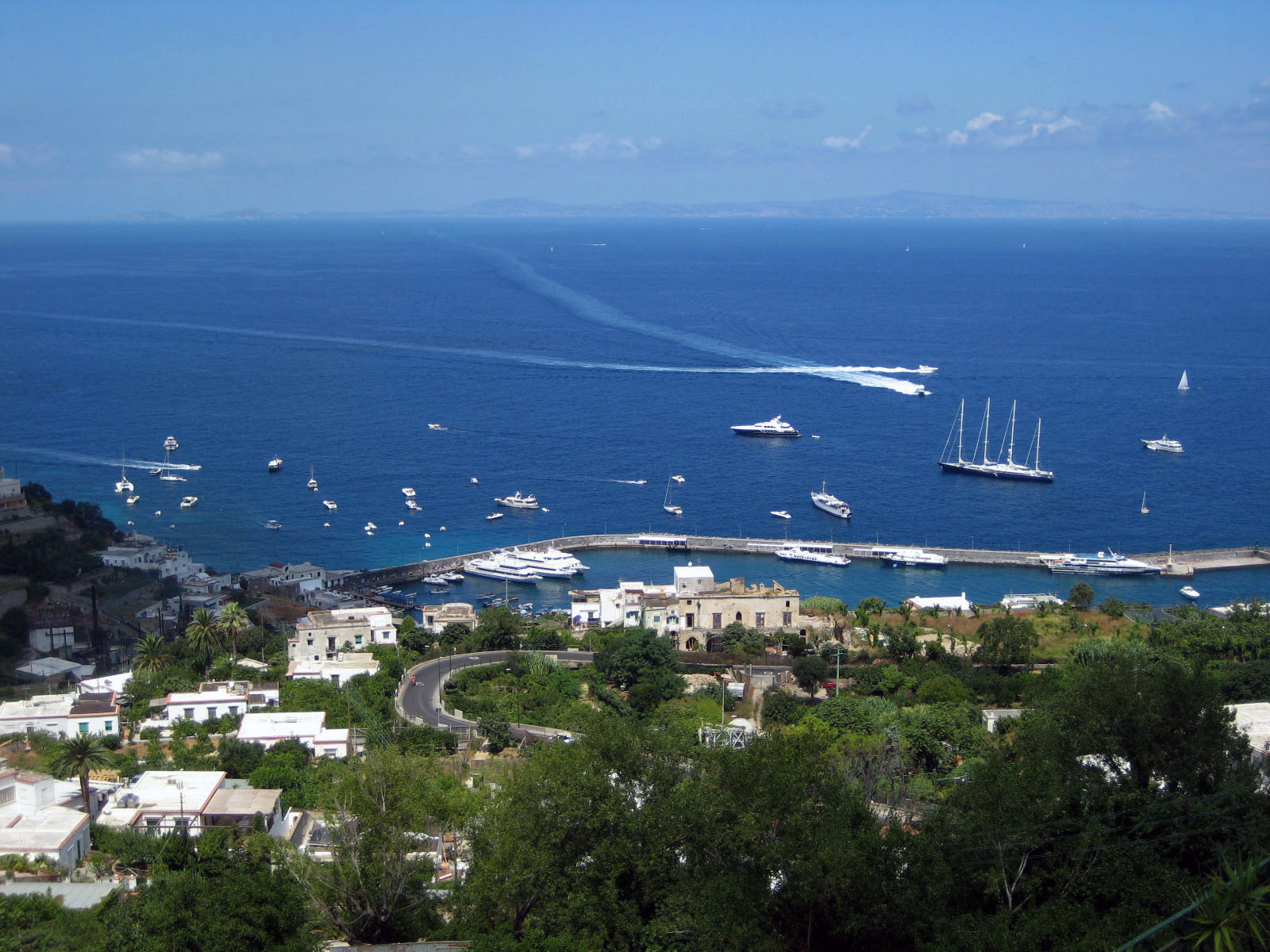 We took the Funicular (cable car) up to Capri town from the Marina Grande below. It’s a 5 minute ride up the hill squashed back to belly with every nationality in the world; kind of like a United Nations in a sardine can. The first thing everyone does when they get off the cable car is to run over to the most magnificent view of the harbor below and snap off hundreds of photos. I was right there with them.
We took the Funicular (cable car) up to Capri town from the Marina Grande below. It’s a 5 minute ride up the hill squashed back to belly with every nationality in the world; kind of like a United Nations in a sardine can. The first thing everyone does when they get off the cable car is to run over to the most magnificent view of the harbor below and snap off hundreds of photos. I was right there with them.
The line for the cable car was way too long for our trip down so we walked down the street and waited for the bus. The streets of Capri are so small, two buses passing on a hillside are only separated by a thin layer of paint. It’s almost like your sitting next to the person in the bus going the opposite direction.
Capri is the island of celebrities. In the 1960’s Jackie Kennedy made a famous visit. Around the same time, Mary Tyler Moore started wearing Capri pants on the Dick Van Dyke Show. Soon after, this little island became the “place to be” for American celebrities. We did see one photo of Jackie Kennedy but most of the windows are reserved for more recent celebrities. They ranged from Barbara Streisand (in a very unflattering pose) eating a gelato, Dustin Hoffman painfully acknowledging his hosts with two photos at one restaurant, Nicolas Cage in one window and Nicolas Cage in three more. There was Elton John and Bobby Kennedy and more shots of Mariah Carey than 10 National Enquirer type rags would have shown of her in a year. She must have spent a week posing for photos. The glitterati love this place and even if they’re not famous, the sure dress like they are. We saw one ancient woman in gladiator boots, tight gold lamé pants and an embroidered vest. She looked like she came to the island when Emperor Augustus lived here.
When Augustus Caesar did come here on his way back from an eastern campaigns, he liked it so much he built a holiday home here. Augustus’s successor Tiberius exiled himself from Rome, he (more or less) ruled the empire from 27 – 37 AD from his home in Capri. There are ruins of a few Roman villas on the island, but Tiberius’ Villa Jovis is the most famous. It covered close to 2 acres built on a slope over 1,000 feet above the sea, built in a series of levels and terraces.
There were apartments, baths, palestras, entertaining rooms and things we can only imagine. From the lowest terrace to the highest level was over 130’ tall.
According to Suetonius, the Roman gossipmonger, Tiberius used the Villa Jovis for wild orgies, to the point of throwing women off the cliff to the rocks below. Of course, these tales of bad behavior might just be rumors from the enemies of Tiberius in the Roman Senate.
 We followed a small group to the Gardens of Augustus, a beautiful and relaxing lush garden with breath taking views of the Faraglioni (big sea rocks) and the turquoise waters below. It’s named for Augustus but I really doubt if he ever used it as a garden.
We followed a small group to the Gardens of Augustus, a beautiful and relaxing lush garden with breath taking views of the Faraglioni (big sea rocks) and the turquoise waters below. It’s named for Augustus but I really doubt if he ever used it as a garden.
On one side of the lush gardens is the ocean. On the other, a switchback walking road known as Via Krupp down to the Marina Piccola. Both the garden and the walking road were once owned by Friedrich Alfred Krupp, the heir to the Krupp Steel fortune.
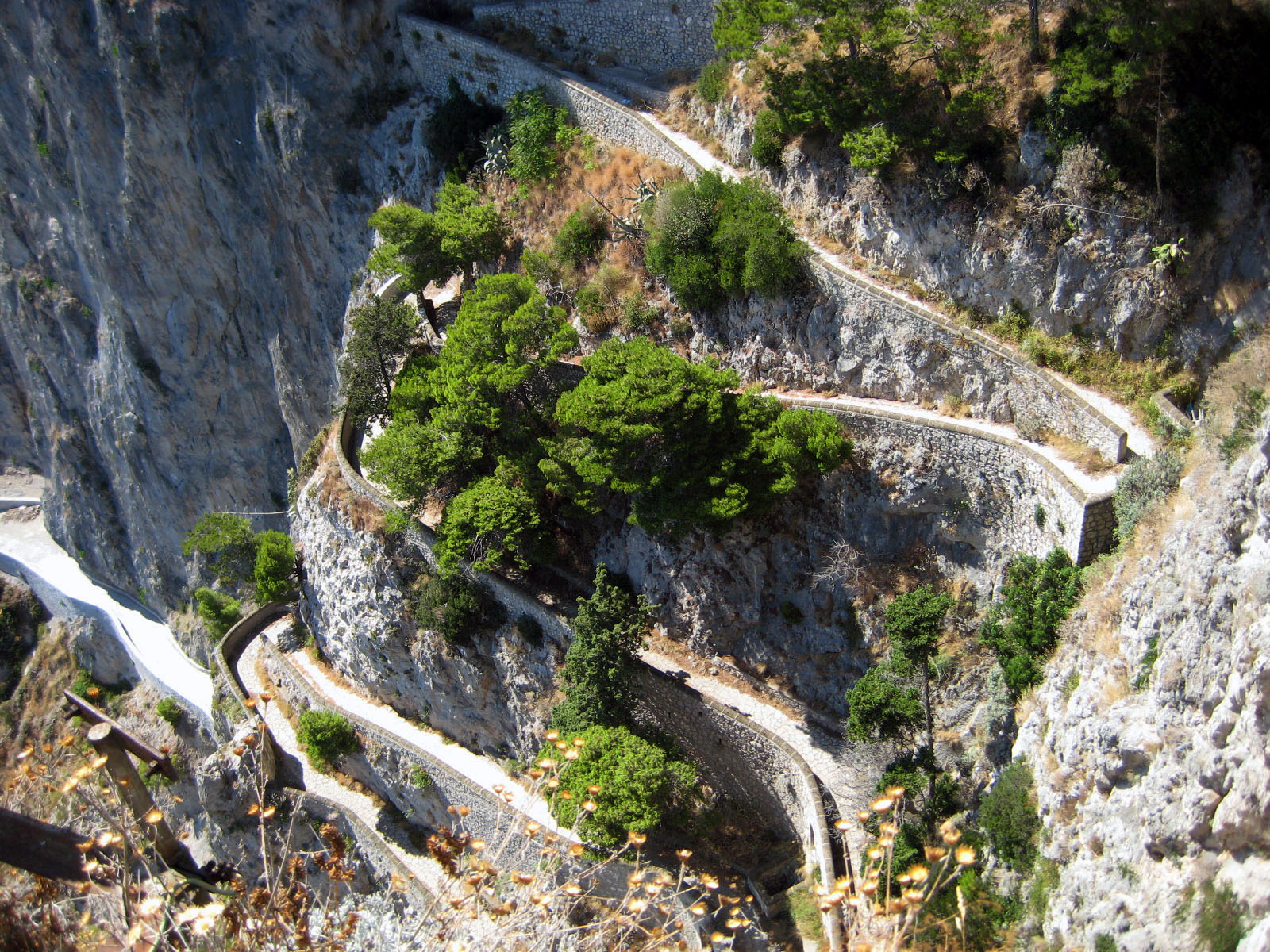 He settled in Capri in the late 1800’s under the guise of doing biological research, but when it was discovered he was supplying young Capri boys to the Bristol Hotel in Berlin for pederastic pleasures, his life went into a tailspin.
He settled in Capri in the late 1800’s under the guise of doing biological research, but when it was discovered he was supplying young Capri boys to the Bristol Hotel in Berlin for pederastic pleasures, his life went into a tailspin.
In 1902, Krupp was brought before the Italian courts for the corruption of the local youth. Within a week of the trial he went back to Germany and killed himself.
The Ottoman Pirate Barbarossa also plays a part on the islands history back in the 15th century when he was fleet Admiral under Suleiman the Magnificent. By the way, he didn’t have a red beard, as the name suggests. Barbarossa was a mutilation of Baba Oruce, a name he inherited from his older brother.
Amongst the “must do” itineraries on the island are visits to the grottos, the partially submerged cave opening into the sea. It was another of the places we wanted to go but the crowds were absurd.
The Blue Grotto is the most famous of the sea caves on Capri but it’s more of a contemporary attraction. There are stories that the Romans used the it as a private bath, but there is no substantiated proof. However, until about a hundred years ago, the inhabitants of the island used to be afraid of the eerie blue color the reflection of the sun gave off on the cave walls. They were certain it was populated by evil witches and monsters. Who knows, maybe it is. But that hasn’t stopped the millions of tourists visiting each year.
The island of Ischia is more than twice the size of Capri. It about the same distance from Naples by boat, around 40 minutes. Ischia is beautiful and it’s a popular destination for Italians and Germans, but never got the international nod of Capri. Still, the main industry of the island is tourism.
The port of Ischia is a mess of tourist shops, car rentals, bus terminals and ferry docks, but a short walk away are beautiful streets, quaint shops, an amazing 15th century castle fortress and the lots thermal therapeutic baths. The island is famous for it’s therapeutic water.
Ischia brings in around 6 million visitors per year, mainly from the Italian mainland but the Germans have also been here for a few years. After World War II, German soldiers came here for the healing therapeutic waters. The cures seem to work and they stayed. Today about 40% of the island is German. It’s the second language. Every shop lists their items in Italian and German. No matter how these two cultures felt about each other 60 years ago, they are the best of friends on Ischia.
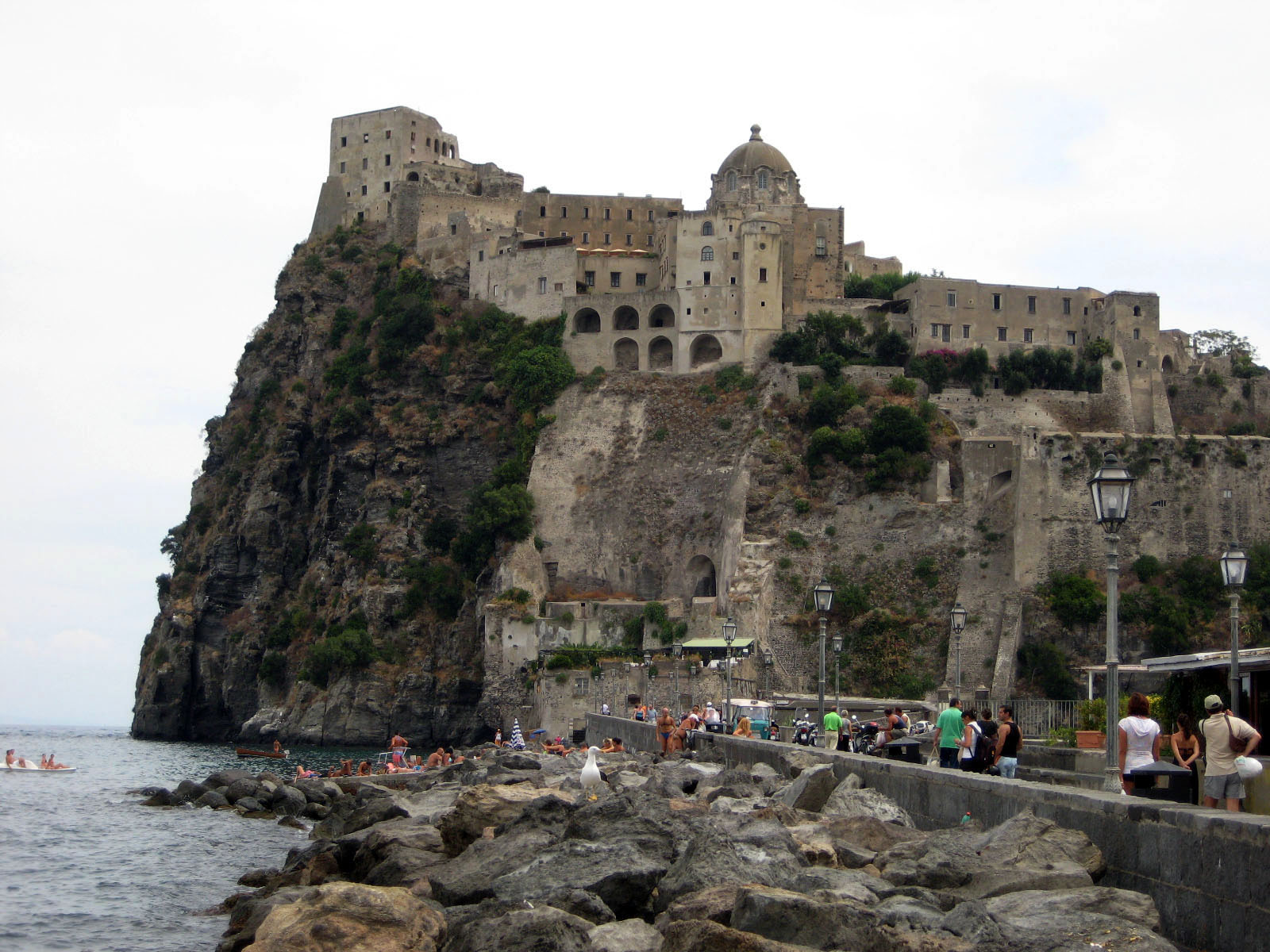 The foundations of the Aragonese Fortress go back to the 5th century but what we see today are all 15th century. When the local Volcano, Mount Epomeo blew everything in 1441, Alphonso of Aragon rebuilt the old Angevin fortress. He also built the bridge that connect the fortress to the main island. The 15th century was also when our favorite Ottoman pirate, Barbarossa was pillaging the island. Historians have estimated he took over 4,000 prisoners from Ischia alone. Over 1900 people from the island took refuge inside the Fortress walls during his period of raids. Actually, the pirate raids on the island went on till 1796. Then Napoleon came. It’s hard to tell which was worse.
The foundations of the Aragonese Fortress go back to the 5th century but what we see today are all 15th century. When the local Volcano, Mount Epomeo blew everything in 1441, Alphonso of Aragon rebuilt the old Angevin fortress. He also built the bridge that connect the fortress to the main island. The 15th century was also when our favorite Ottoman pirate, Barbarossa was pillaging the island. Historians have estimated he took over 4,000 prisoners from Ischia alone. Over 1900 people from the island took refuge inside the Fortress walls during his period of raids. Actually, the pirate raids on the island went on till 1796. Then Napoleon came. It’s hard to tell which was worse.
The English bombed the hell out of it when Napoleon’s French were there. When the King of Naples reclaimed it, he used it for a prison all the up till the unification of Italy in 1867.
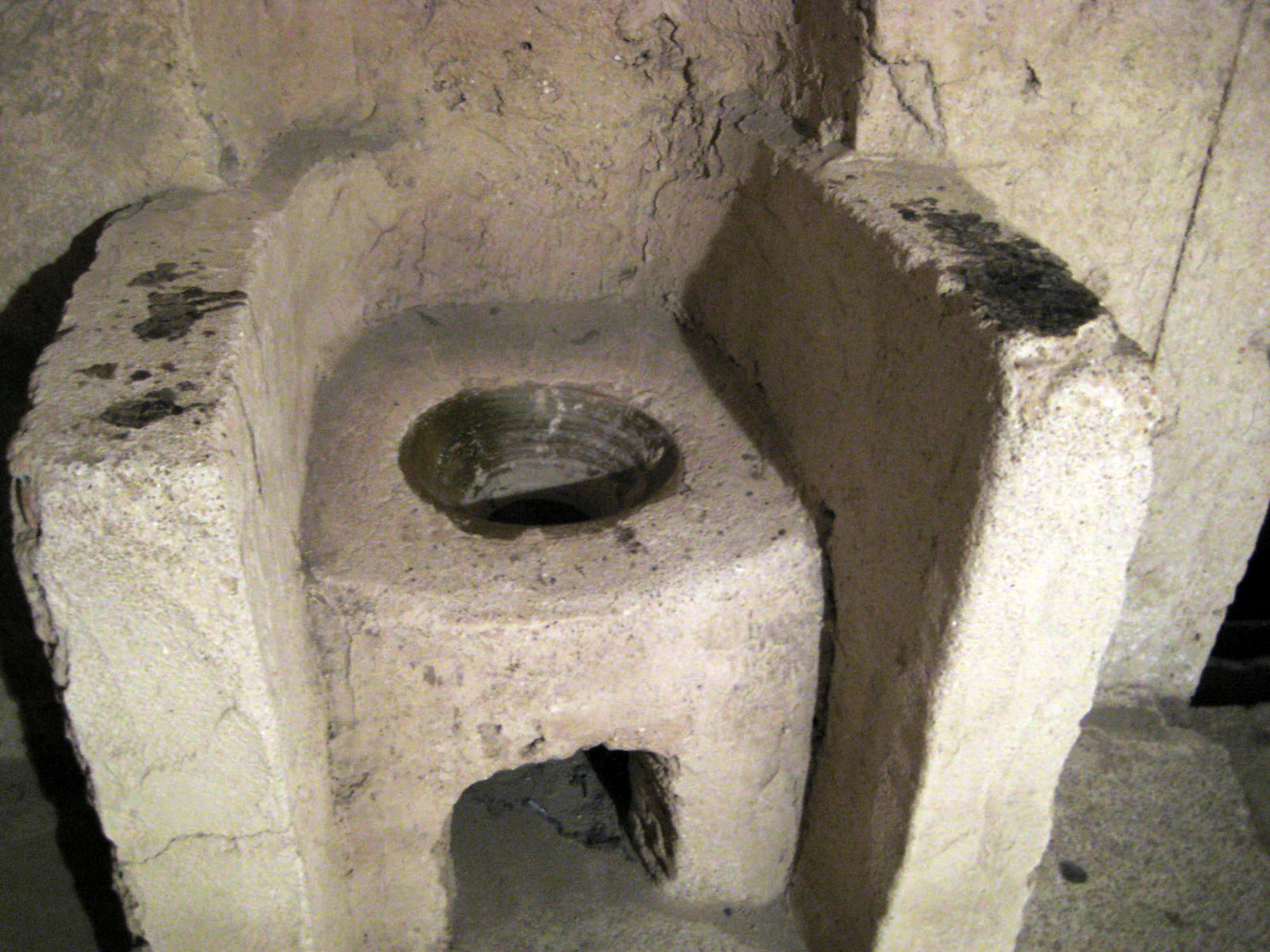 But the weirdest of all in the fortress has to be the Convent of the Nuns of St Clarisse. These nuns are a Franciscan order, but in this case they’re more related to the bizarre Cappucin monks of Rome than the Poor Claire sisters.
But the weirdest of all in the fortress has to be the Convent of the Nuns of St Clarisse. These nuns are a Franciscan order, but in this case they’re more related to the bizarre Cappucin monks of Rome than the Poor Claire sisters.
Some might know the Cappucin monks as the origin of the cappuccino coffee drink because the foam on top of the coffee resembles the hoods of their robes. But there is a lot more to them than the old timey robes. The Cappucini have mastered the art form of creating mosaic wall art from the bones of their dead brethren. Their church on the Via Veneto in Rome is a must for searchers of the bizarre.
The Cappucin is weird and spooky, but the the Nuns of St Clarisse are downright disgusting. When a cloistered nun of the order died, her lifeless, naked body was seated on a stone chair and left to decompose. There is a hole in the bottom of the chair so the body fluids would drain into some kind of container. In fact, the nuns (the living ones, that is) would put candles under the seat to help speed up the draining, although the process was never that fast. From what we read, it could take years before the process was completed. The living nuns would pray in the room directly next to the rotting corpses; so much for hygienic conditions in a house of worship.
When all that remained was a dried skeleton, the bones were deposited into a vault. The nun’s kept up this medieval practice of draining their sisters till the 1970’s. We still have no idea of what they did with the fluids. We can only imagine.
Why did they do it? We were told to highlight the human body as just a container for the spirit. The Nuns wanted to prove the body had no use after the soul was done with it. Not a good enough explanation. They were just plain weird. And how did they get away with doing it till the 1970’s?

You must be logged in to post a comment.